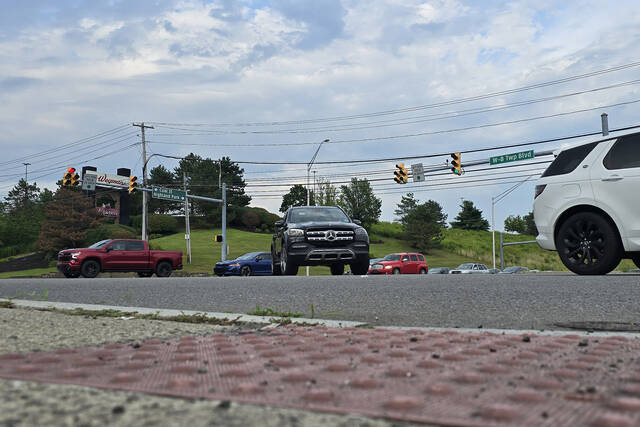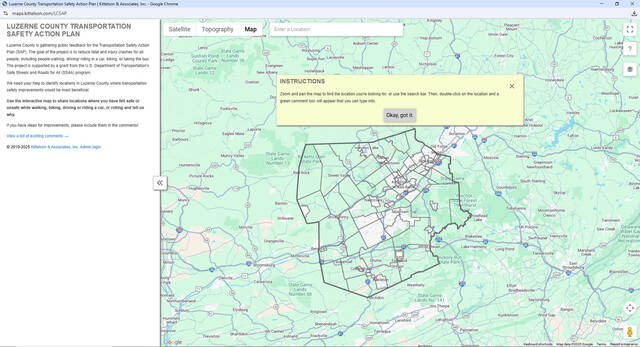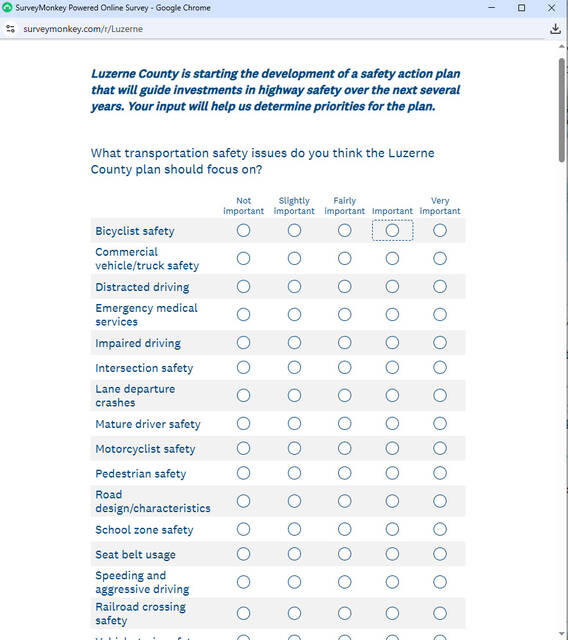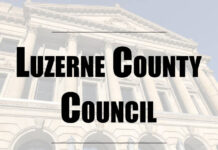
Traffic moves at the intersection of Wilkes-Barre Twp. Boulevard and Coal Street/Highland Park Boulevard on Saturday evening.
Elizabeth Baumeister | Times Leader
If you’re concerned about a safety issue on any roadway in Luzerne County, there’s now a chance to do something about it.
The county GIS/Planning and Zoning Department is seeking citizen feedback on safety issues impacting vehicles, buses, pedestrians and bicyclists for a new transportation safety action plan that will document concerns in one report and possibly help secure funding to correct them.
This plan covers all roads within the county, not only those that are county-owned, said acting GIS/Planning and Zoning Director Dan Reese and county Grant Writer Michele Sparich, who has been temporarily overseeing the operational services division.
“We want as much public input as we possibly can get on this,” Reese said. “This is a clearinghouse for all safety issues in this county.”
The study will detect some accident risks through a review of crash statistics, but Reese said the public is aware of other potential dangers that have not yet resulted in accidents.
He gave a hypothetical example of a rural spot where someone went off the road due to its design or inadequate or missing signs warning of a turn or other hazards.
Faded or confusing painted markings on a roadway could be another safety concern if they leave motorists in the dark about which lanes they must be in to proceed forward or turn, he said.
Reese said he has personally observed pedestrian signal crosswalks in which the lighted indicators to both walk and stop are simultaneously illuminated, which is a signal maintenance issue.
“That’s really why we’re trying to get public input to identify these areas throughout the county,” he said.
Submitting concerns is easy because the county has posted an online map on the planning/zoning department’s “Safe Streets For All” section at luzernecounty.org. Pinpoint the location at issue and double-click. A box pops up to explain the safety issue, and submission of the poster’s name and contact information are optional.
There’s also a link to a survey that includes a spot for specific location concerns and a “story board” outlining the safety action plan purpose.
Aiming to maximize participation, Reese and Sparich have been setting up information stations about the study at public events and have scheduled two public workshops to gather in-person input on safety concerns:
• July 30, 4:30 to 6:30 p.m., Hazleton City Hall, 40 N. Church St. in the city.
• July 31, 4:30 to 6:30 p.m., JCC of Wyoming Valley, 613 S.J. Strauss Lane in Kingston.
Residents can stop in at any time during these sessions.
Study need
From 2019 through 2023, there were 16,302 traffic crashes in the county, resulting in about 34 fatalities per year, the county’s online story board said.
“Every one of those fatalities, and the 552 crashes resulting in severe injuries, has a significant impact. They dramatically affect (or even end) the life of the victim and alter the lives of countless family members, friends, and co-workers around them,” it said.
The storyboard maps out the locations of fatal crashes and suspected severe injury crashes.
It also notes there were 68 bicyclist crashes and 260 pedestrian crashes in the county between 2019 and 2023.
Once the plan is completed, the county and its municipalities will be eligible for additional funding to implement plan recommendations.
The county is funding the study, performed by Kittelson and Associates Inc., with a $200,000 Safe Streets and Roads For All grant awarded through the U.S. Department of Transportation.
The public comment period will run through September.
Reese and Sparich said government entities will be able to seek funds remaining from the federal Infrastructure Investment and Jobs Act to address safety concerns identified in the final safety action plan. Approximately $2 billion currently remains for safe streets projects, Reese said.
Interstates 80 and 81 will be covered separately in the safety plan because other funding sources are available to complete safety improvements on this major infrastructure, Reese said.
Even after federal funding from the infrastructure bill is exhausted, the safety plan will be valuable for state, county and municipal officials to prioritize work that should be completed if other revenue is identified, Reese and Sparich said.
Sparich said some safety enhancements may not require significant expense to correct.
The safety plan will also ensure government officials are made aware of concerns on their roadways, particularly if multiple people report problems about the same location, she said.
Reach Jennifer Learn-Andes at 570-991-6388 or on Twitter @TLJenLearnAndes.





